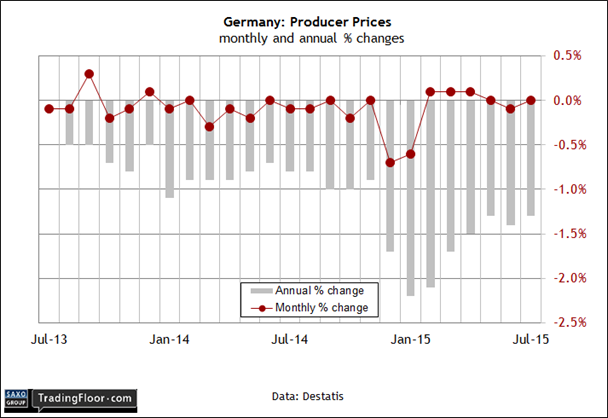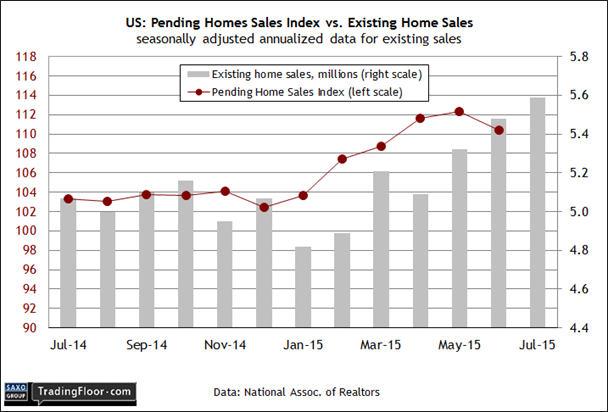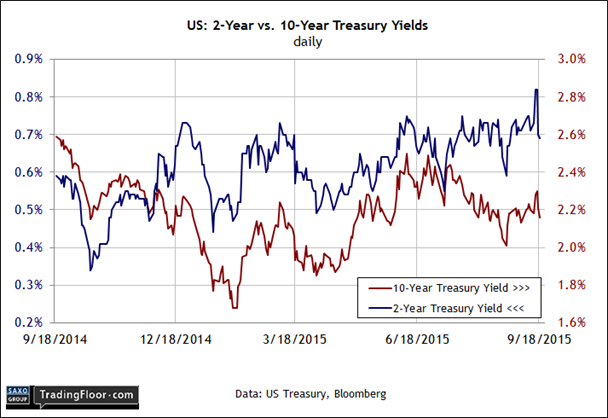- Is deflation risk on the rise in Europe? Producer prices for Germany may tell us
- Will US existing home sales remain at an eight-year high in today’s release?
- The 2-year US Treasury yield could tumble further after last week’s Fed decision
There are many questions weighing on the global markets in the aftermath of last week’s decision by the Federal Reserve to leave interest rates unchanged. However, new insights into the state of macro conditions will be in short supply today, thanks to a light schedule for economic releases.
The main event for Europe is an update on producer prices in Germany. For the US, we’ll see the August report on existing home sales. Meantime, keep an eye on the 2-Year Treasury yield for a real-time update on sentiment in the wake of the Fed’s reluctance to tighten monetary policy last week.
Germany: Producer Price Index (0600 GMT): Deflation risk is back on the table as a real and present danger in the wake of the Federal Reserve’s decision to punt on raising interest rates.
Actually, the threat of falling prices was there all along. The difference now is that there’s a higher degree of formal recognition (courtesy of the world’s most important central bank) that deflation risk is lurking. If you cut through all the technical chatter, that’s the main message in the Fed’s preference to forgo a rate hike.
Headline inflation for the US in annual terms is expected to hover at just above zero - around 0.4% - for all of 2015, according to the Fed’s revised economic projections. That's down slightly from the central bank’s June forecast. Core inflation's outlook is higher, currently on track for a 1.7% rise this year, but here too the Fed lowered its estimate slightly relative to the previous forecast.
None of this comes as a shock for Europe, where varying degrees of disinflation and outright deflation have been a constant in recent years. Germany is no exception, despite its role as the currency union’s most reliable source of growth. Indeed, producer prices in Europe’s biggest economy have been sliding in year-on-year terms for the last two years and that’s not going to change in today’s update.
The main question for today’s release: Is deflation’s momentum picking up speed? The stakes are higher now that we know that the Fed remains cautious. Recent history suggests that deflation’s bite was receding in Germany’s producer price index – the annual decline was 1.3%through July, down from the low 2% slide in this year’s first quarter. Has the mild progress evaporated?
The good news is that the outlook for modest growth for the Eurozone remains intact, according to Friday’s weekly update of Now-casting.com’s estimate for third quarter GDP growth. The 0.36% quarter-on-quarter gain is still slightly below Q2’s 0.4% advance, but the weekly estimates have been inching higher lately. Is that a sign that deflation risk isn’t accelerating? Possibly, although it’ll be harder to make that case if today’s update on producer prices in Germany for August fall below July’s 1.3% year-over-year slide.
That's a possibility. Danske Bank last week predicted that Eurozone consumer inflation was temporarily headed back into negative territory in September in year-on-year terms for the first time since March. If so, the pressure will increase on the European Central Bank to increase its asset purchases. Deciding if that’s a plausible scenario starts by reviewing today’s producer inflation data for Germany.

US: Existing Home Sales (1400 GMT): Last week’s update on residential housing construction for August brought mixed news - a deeper-than-expected decline in housing starts for the monthly comparison while the annual pace picked up to a healthy 16.5% increase. Overall, a decent report if you look past the short-term noise. But given the Fed’s cautious stance that left its policy rate unchanged, it’s reasonable to wonder if the US macro trend is headed for a rough fourth quarter.
Today’s monthly release on the appetite for home purchases will offer new guidance. The rear-view mirror suggests that a bullish wind is blowing. Existing sales rose to an eight-year high in July. Today’s data is probably due for a pullback from that peak, although a softer number won’t threaten the upward trend that’s been in place since late-2014 in terms of the annual pace.
Short of a massive tumble, today’s data is on track to reaffirm the upbeat year-on-year trend that’s been in force this year. Econoday.com’s consensus forecast advises that sales will retreat to a 5.50 million seasonally adjusted annual rate in August from 5.59 million in the previous month. But that still leaves purchases at the third highest level since 2007 and ahead by a solid 10% against the year-earlier level. In that case, the softer tone in last month's demand will look like a pause rather than an early warning sign that the market’s cracking.

U.S: 2-Year Treasury Yield: The market’s still debating the ramifications of last week’s no-hike Fed decision, although one immediate result is the revival of demand for the safety of government bonds. That's a stark change from the mood that prevailed in the days ahead of the Fed announcement.
On the eve of the central bank’s September 17 policy update, the 2-year Treasury yield - considered the most sensitive for rate expectations – was trading at a new four-year high of 0.82%. But the outlook for higher rates was trashed when Federal Open Markets Committee chair Janet Yellen and company decided to leave rates unchanged. By the end of trading on Friday, thetwo-year yield tumbled to 0.69% - close to a three-week low, based on Treasury.gov’s daily data.
The revival in risk aversion is all about the implied message in the Fed’s reluctance to move its policy rate above the 0%-0.25% target that has been in place for six years. The optimistic view from a macro perspective is that delaying a rate hike is a nod to heightened uncertainty in global markets that was triggered by China’s currency devaluation last month. The US economy, according to this narrative is still humming along at a moderate growth rate and so a rate hike will come later in the year.
The alternative view is that the Fed postponed the launch of policy tightening because the outlook has turned darker for the US economy. One of the more bearish interpretations is that the decision for no change in rates is a prelude to QE4 – a new phase in quantitative easing (buying assets with newly printed money) to offset the coming macro deceleration.
Deciding how to interpret last week’s dovish monetary decision based on the hard data will take time. Meanwhile, it’ll be interesting to see how the Treasury market reacts after a weekend of digesting news and commentary.
As for official expectations, the revised outlook for the Fed funds rate for 2016 still calls for a relatively hefty rise from the current 0%-1.4%, based on the median projection of FOMC members. The burning question for today is whether Mr Market’s still on board with that outlook.

Source: US Treasury, Bloomberg.
Disclosure: Originally published at Saxo Bank TradingFloor.com
